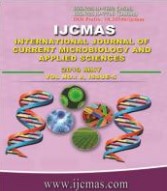


 National Academy of Agricultural Sciences (NAAS)
National Academy of Agricultural Sciences (NAAS)

|
PRINT ISSN : 2319-7692
Online ISSN : 2319-7706 Issues : 12 per year Publisher : Excellent Publishers Email : editorijcmas@gmail.com / submit@ijcmas.com Editor-in-chief: Dr.M.Prakash Index Copernicus ICV 2018: 95.39 NAAS RATING 2020: 5.38 |
Studies on population dynamics of thrips on tomato crop were carried out during two consecutive kharif seasons (2016 and 2017). The observations viz., number of adult thrips and associated GBNV disease and natural enemies were recorded at weekly intervals. The results revealed that, thrips activity found throughout the cropping period. The population of thrips was increased gradually from first week after transplanting to flowering and fruit development stage and later it was decreased as crop matures. During 2015-16 kharif crop, maximum thrips population (8.40 thrips/three leaves) was observed during the last week of November and first week of December. Similarly during 2016-17 kharif crop, maximum thrips population (10.30 thrips/three leaves) was observed during third and last week of December. The population of zoopytophagous miridbug, Nesidiocoris tenuis Reuter was found linear with the population of thrips during both the seasons. The percent disease incidence of GBNV on tomato crop was linier with the thrips population during both the seasons. The cumulative disease incidence was 42.50 % and 45.10 % during first and second seasons respectively. Correlation studies indicated that, minimum temperature, rainfall, rainy days and evening relative humidity were found significant negative correlation with the thrips population, while sunshine hours and morning relative humidity found significant positive correlation with the thrips population.
 |
 |
 |
 |
 |